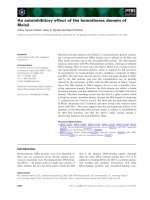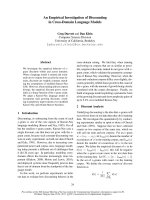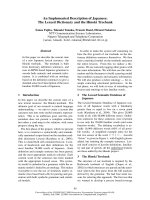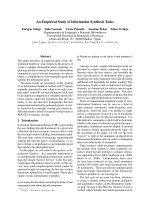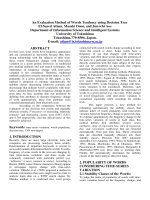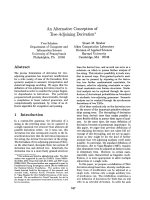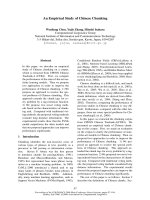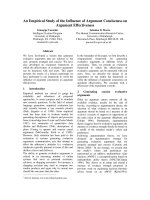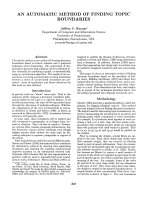Báo cáo khoa học: "An unusual cause of chyluria after radiofrequency ablation of a renal cell carcinoma: a case report" docx
Bạn đang xem bản rút gọn của tài liệu. Xem và tải ngay bản đầy đủ của tài liệu tại đây (655.71 KB, 3 trang )
CAS E REP O R T Open Access
An unusual cause of chyluria after radiofrequency
ablation of a renal cell carcinoma: a case report
Tze Min Wah
Abstract
Introduction: This report highlights a rare cause of chyluria occurring after radiofrequency ablation of a renal cell
carcinoma. The condition requires a high index of suspicion, as it may not be diagnosed routinely on imaging
follow-up after treatment. As chyluria can vary from no symptoms to hypoproteinemia, hypolipidemia and
impaired immune function, prompt diagnosis will allow timely management of symptoms.
Case presentation: During a routine renal examination, an otherwise fit and well 79-year-old Cauc asian man was
found to have a peripherally situated tumor. He underwent renal radiofrequency ablation as primary treatment.
Periodic imaging follow-up over two years showed no evidence of residual or recurrent disease within the zonal
ablation. The routine imaging protocol at St James’s Hospital included upper abdomen only for kidney assessment;
pelvic examination was not included. However, our patient underwent a computed tomography scan of his
abdomen and pelvis at the request of his local urologist, around two and a half years after the renal
radiofrequency ablation. A fat-fluid level was seen within the urinary bladder, consistent with chyluria. As our
patient was asymp tomatic, he was treated conservatively.
Conclusion: It is important to be aware of chyluria as a possible complication of renal radiofrequency ablation, and
to recognize the fat-fluid level sign within the bladder or collecting system on computed tomography scans. As most
institutions do not routinely perform computed tomography scans of the pelvis as part of their follow-up protocol
after renal radiofrequency ablation, a high index of suspicion is required for diagnosis. Routine urine analysis for fat
should be considered, as prompt diagnosis is crucial to guide management for symptomatic patients.
Introduction
Image-guided percutaneous renal radiofrequency ablation
(RFA) therapy is now an increasingly popular treatment
for small and selected renal cell carcinoma. It has low
morbidity, high technical success and good mid-term out-
come results [1,2]. After renal RFA, treatment eff icacy is
usually monitored by periodic cross-sectional imaging,
with either computed tomography (CT) or magnetic reso-
nance imaging. Most institutions, especially in Europe,
only perform cross-sectional imaging of the kidneys; the
pelvis is not routinely imaged as part of the follow-up. I
report a case of incidental diagnosis of chyluria on CT in a
patient who had undergone renal RFA for a small left
renal cell carcinoma. This case report highlights a rare but
important cause of chyluria after renal RFA. Clinicians
need to have a high index of suspicion, as this condition
may not be diagnosed routinely on imaging follow-up. As
chyluria can present with varying degrees of severity,
prompt diagnosis would allow timely management of
symptoms.
Case presentation
A 79-year-old Caucasian man with benign prostatic
hypertrophy underwent a routine renal ultrasound exam-
ination for lower urinary-tract symptoms. He was found
to have a peripherally situated tumor 21 mm in size. He
had no other relevant medical history and his serum
creatinine was within normal limits (104 μmol/L). He
was referred to my department for consideration of per-
cutaneous renal RFA. This case was discussed at the local
urology multidisciplinary meeting, where the consensus
was to offer surgery such as radical or partial nephrect-
omy or percutaneous RFA. The treatment options and
risks were discussed in detail with our patient, who
Correspondence:
Clinical Radiology Department, St James’s University Hospital, Leeds
Teaching Hospitals Trust, Leeds, LS9 7TF, UK
Wah Journal of Medical Case Reports 2011, 5:307
/>JOURNAL OF MEDICAL
CASE REPORTS
© 2011 Wah; lic ensee BioMed Central Ltd. This is an Open Access article distributed under the terms of the Creative Commons
Attribution License (http:// creativecom mons.org/licenses/by/2.0), which permits u nrestricted us e, distribution, and reproduct ion in
any medium, provided the original work is properly cited.
agreed to proceed with percutaneous RFA as f irst-line
treatment.
The procedure was performed under general anesthesia.
A 16G co-access sheathed needle system (Boston Scienti-
fic, Boston, MA, USA) was inserted into the tumor under
imaging guidance, using a combination of ultrasound and
contrast-enhanced CT (10 0 mls Ultra vist 300; Schering
AG, Berlin, Germany). An 18G needle core biopsy of the
tumor was obtained, immediately followed by the insertion
of a Le Veen RFA array probe (Boston Scientific) with a
diameter of 30 mm. Three overlapping treatments were
performed, with a total ablation time of 20 minutes and 50
seconds. Our patient was given 80 mg gentamicin intrave-
nously as prophylaxis. Histological examination of the
tumor biopsy confirmed a grade 2 conventional renal cell
carcinoma. Our patient was able to pass urine adequately
after the procedure, and was discharged on the following
day with stable renal function (creatinine 100 μmol/L). He
was followed up with imaging at one, three, six and twelve
months. Repeat imaging two years after the operation
showed no evidence of residual of recurrent disease within
the treated area (Figure 1). At St James’s Hospital, the rou-
tine imaging protocol includes only the upper abdomen
for kidney assessment; pelvic examination is not included.
However, around six months later (about two and a half
years after the surgery), our patient underwent a CT scan
of his abdomen and pelvis at his local hospital at the
request of his local urologi st. A fat-fluid level was seen
within the urinary bladder, consistent with chyluria
(Figure 2). As he was asymptomatic, he was treated
conservatively.
Discussion
Chyluria is rare, and is caused by communication
between the lymphatic a nd urinary tract systems. It is
usually secondary to filari asis infection [3]. Other causes
include abscesses, tumor, tuberculosis and congenital
conditions. These are usually due to rupturing of the
lymphatic system into the pelvicalycea l system. Rarely,
iatrogenic causes of chyluria have been described after
radical and partial nephrectomy, resulting in a fistulous
connection from the lymphatics to the collecting system
[4-6]. Interestingly, two cases of asymptomatic chyluria
were recently diagnosed during routine follow-up after
renal RFA in California, USA, where the routine ima-
ging included both the abdomen and pelvis [7].
Renal RFA has been in practice for over 10 years and it
is interesting t o note that many complications related to
the procedure have been well reported but, until recently,
chyluria was not one of the se. Because my hospital does
not usually include pelvic examination during follow-up,
it is likely that the diagnosis of asymptomatic chyluria
after renal RFA will be missed unless the patient is symp-
tomatic. In the case described here, the diagnosis only
came to light when our patient’s pelvis was sc anned for
other clinical reasons. The lack of reports of chyluria
after renal RFA to date could be related to the fact that
most follow-up protocols do not routinely include exami-
nation of the pelvis. However, it is extremely important
to recogni ze the fat -fluid level sign in the bladder or col-
lecting system on CT, especially in patients with a pre-
vious history of renal ablation. Early recognition would
allow prompt diagnosis of chyluria. As chyluria can vary
Figure 1 Axial section of co ntrast-enhanced CT of his left
kidney after RFA shows the treated region (white arrow) with
no evidence of residual or recurrent disease at two years after
RFA.
Figure 2 Axial section of contrast-enhanced CT of the bladder
shows a fat-fluid level (black arrow) within the bladder,
consistent with chyluria.
Wah Journal of Medical Case Reports 2011, 5:307
/>Page 2 of 3
from no symptoms to hypoprotei nemia, hypolipidemia
and impaired immune function, prompt diagnosis wo uld
allow timely management of symptoms [8]. Usually,
symptomatic patients report milky-white urine, and fat
can be dete cted on urine analysis. Treatments include
nutritional support, renal sclerotherapy and surgical liga-
tion of the lymphatic system [4,9].
Conclusion
It is important to be aware of chylur ia as a complication
after renal RFA, a nd to re cognize the fat-fluid level sign
within the bladder or collecting system on CT. As most
institutions do not routinely perform CT of the pelvis as
part of their follow-up protocol after renal RFA, a high
index of suspicion is required for diagnosis. Routine urine
analysis for fat should be considered in such patients, as
prompt diagnosis is crucial to guide management.
Consent
Written informed consent was obtained from the patient
for publication of this case report and accompanying
images. A copy of the written consent is available for
review by the Editor-in-Chief of this journal.
Competing interests
The author declares that they have no competing interests.
Received: 14 July 2010 Accepted: 13 July 2011 Published: 13 July 2011
References
1. Gervais DA, McGovern FJ, Arellano RS, McDougal WS, Mueller PR:
Radiofrequency ablation of renal cell carcinoma: part 1, Indications,
results, and role in patient management over a 6-year period and
ablation of 100 tumors. Am J Roentgenol 2005, 185:64-71.
2. Zagoria RJ, Traver MA, Werle DM, Perini M, Hayasaka S, Clark PE: Oncologic
efficacy of CT-guided percutaneous radiofrequency ablation of renal cell
carcinomas. Am J Roentgenol 2007, 189:429-436.
3. Diamond E, Schapira HE: Chyluria: a review of the literature. Urology 1985,
26:427-431.
4. Tuck J, Pearce I, Pantelides M: Chyluria after radical nephrectomy treated
with N-butyl-2-cyanoacrylate. J Urol 2000, 164:778-779.
5. Miller FH, Keppke AL, Yaghmai V, Gabriel H, Hoff F, Chowdhry A, Smith N:
CT diagnosis of chyluria after partial nephrectomy. Am J Roentgenol 2007,
188:W25-W28.
6. Kim RJ, Joudi FN: Chyluria after partial nephrectomy: case report and
review of literature. ScientificWorldJournal 2009, 19:2180-2190.
7. Schneider J, Zaid UB, Breyer BN, Yeh BM, Westphalen A, Coakley FV,
Wang ZJ: Chyluria associated with radiofrequency ablation of renal cell
carcinoma. JCAT 2010, 34:210-212.
8. Ciferri F, Glovsky MM: Chronic chyluria: a clinical study of 3 patients.
J Urol 1985, 133:631-634.
9. Zhang XU, Zhu QG, Ma X, Zheng T, Li HZ, Zhang J, Fu B, Lang B, Xu K,
Pan TJ: Renal pedicle lymphatic disconnection for chyluria via
retroperitoneoscopy and open surgery: report of 53 cases with follow
up. J Urol 2005, 174:1828-1831.
doi:10.1186/1752-1947-5-307
Cite this article as: Wah: An unusual cause of chyluria after
radiofrequency ablation of a renal cell carcinoma: a case report. Journal
of Medical Case Reports 2011 5:307.
Submit your next manuscript to BioMed Central
and take full advantage of:
• Convenient online submission
• Thorough peer review
• No space constraints or color figure charges
• Immediate publication on acceptance
• Inclusion in PubMed, CAS, Scopus and Google Scholar
• Research which is freely available for redistribution
Submit your manuscript at
www.biomedcentral.com/submit
Wah Journal of Medical Case Reports 2011, 5:307
/>Page 3 of 3
